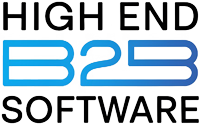Are you tired of using disconnected tools that waste time and frustrate your team?
If you’ve tried to cobble together a CRM, email platform, and sales pipeline, you know how much manual work it takes to keep everything in sync. Best B2B marketing automation platforms.
The good news?
Today’s B2B marketing automation platforms make it easier than ever to manage every part of your funnel—from capturing leads to closing deals—without hiring a giant marketing ops team.
But not all platforms are equal.
Some are clunky, some are overpriced, and some shine only in demos.
That’s why I spent weeks researching, testing, and comparing dozens of tools to find the 10 best B2B marketing automation platforms for 2025.
Below, you’ll find detailed reviews, real user insights, pros and cons, and my honest opinion about who should consider each platform.
1. HubSpot Marketing Hub
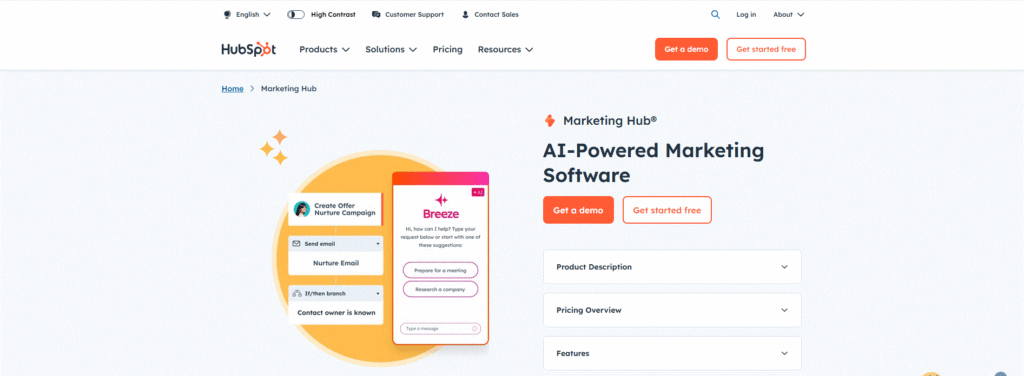
Why I Chose HubSpot
HubSpot is still the gold standard for all-in-one marketing automation, especially if you want a unified CRM, email, sales, and reporting suite.
It’s known for being ridiculously user-friendly while still offering advanced workflows and robust analytics.
My Honest Take on the Features
What sets HubSpot apart is how it lets you:
- Create landing pages with drag-and-drop ease.
- Build powerful workflows that score and nurture leads.
- Sync every activity into a single CRM timeline.
- Track ROI across campaigns.
I’ve worked with clients who switched from cobbled-together tools to HubSpot—and watched them save hours every week.
What Makes HubSpot Different?
Unlike platforms that require tons of add-ons, HubSpot offers everything in one ecosystem, including:
- Marketing automation
- CRM
- Customer service tools
- Sales pipelines
- CMS
This all-in-one model reduces complexity and speeds up onboarding.
Pros
✅ Free CRM forever
✅ Best-in-class training resources
✅ Huge app marketplace
✅ Fantastic onboarding
Cons
❌ Pricing scales quickly as your contacts grow
❌ Some advanced features are locked in higher tiers
Unique Selling Points
All-in-one ecosystem
Built-in ABM tools
No-code automation
Award-winning support
Who Should Use HubSpot?
- SaaS startups ready to scale
- Mid-market B2B companies
- Agencies managing multiple clients
Real User Review
“HubSpot helped us grow from 2 sales reps to a full revenue team of 20. The reporting alone paid for itself in months.”
— Marketing Manager, B2B SaaS (via G2)
2. ActiveCampaign
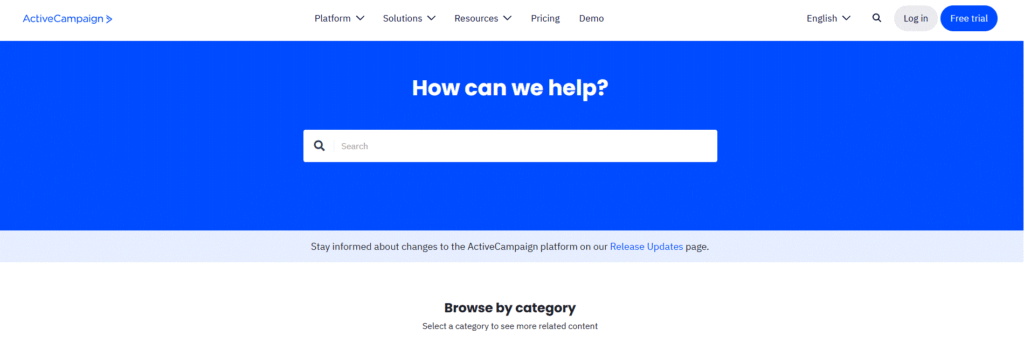
Why I Recommend ActiveCampaign
If you’re serious about behavior-based automation and advanced segmentation, ActiveCampaign is one of the most powerful tools you’ll find—without the enterprise price tag.
My Honest Take
What impressed me most was how visual and flexible their workflow builder is. You can create:
- Dynamic email sequences
- Lead scoring rules
- Conditional content
- Multi-step journeys that adapt as prospects engage
What Makes It Different?
ActiveCampaign has built-in CRM and sales pipelines that integrate natively with marketing workflows—a big plus if you don’t want to bolt on a separate CRM.
Pros
✅ Industry-leading automation features
✅ Affordable even as you scale
✅ Great deliverability
Cons
❌ Can feel overwhelming for new users
❌ Limited design flexibility in forms
Unique Selling Points
Best-in-class segmentation
Customer experience automation
Deep Salesforce and Shopify integrations
Who Should Use ActiveCampaign?
- Growing B2B teams
- Agencies wanting to automate client funnels
- SaaS companies that rely on personalized nurture
Real User Review
“ActiveCampaign let us automate everything from onboarding emails to renewal reminders. We’ve saved dozens of hours each month.”
— Operations Director, Digital Agency (via Capterra)
3. Marketo Engage
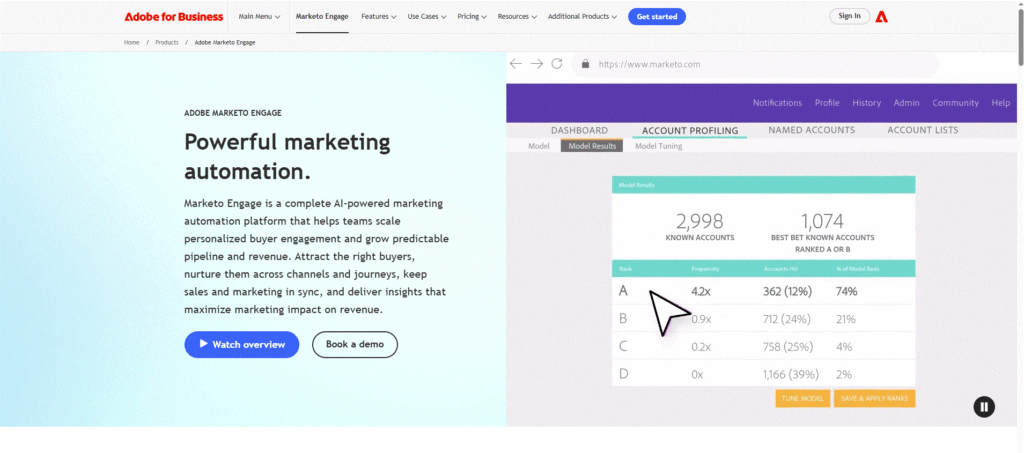
Why It Made My List
Marketo has long been the go-to solution for enterprise B2B marketing automation—especially if you need robust lead scoring, advanced analytics, and powerful integrations.
My Honest Take
Marketo isn’t the cheapest or simplest, but it’s incredibly robust. Once set up, it becomes the backbone of your marketing stack.
What Makes Marketo Different?
No other platform has such a mature ecosystem of:
- ABM features
- Lead lifecycle management
- Multi-touch attribution modeling
If you have a dedicated ops team, Marketo gives you near-unlimited flexibility.
Pros
✅ Deep enterprise-level features
✅ Best for ABM campaigns
✅ Huge partner ecosystem
Cons
❌ High learning curve
❌ Expensive setup and licensing
Unique Selling Points
True enterprise-grade customization
Advanced reporting and ROI tracking
Built for large teams
Who Should Use Marketo?
- Large B2B companies with big budgets
- Teams with marketing operations expertise
- Enterprises running complex nurture programs
Real User Review
“Marketo took our demand generation to the next level. The segmentation capabilities are unmatched.”
— Senior Marketing Director, B2B Tech (via G2)
4. Pardot by Salesforce
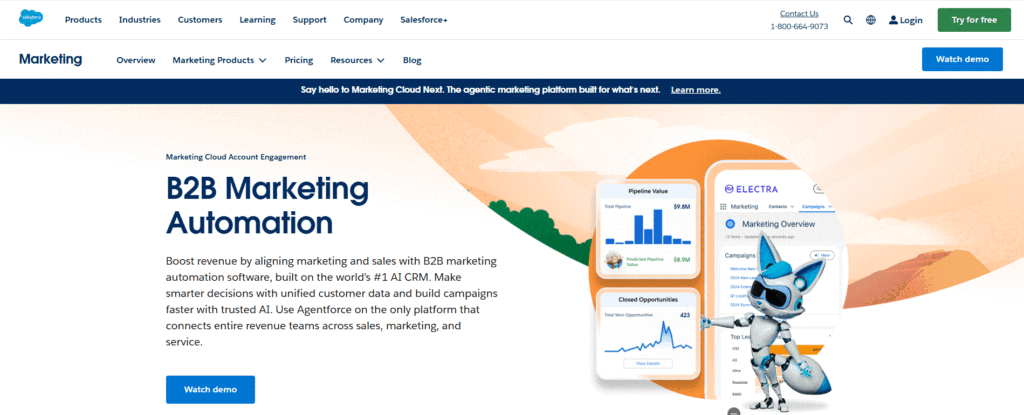
Why I Added Pardot
If you’re already using Salesforce CRM, Pardot is the most natural extension for your marketing automation.
It’s purpose-built for B2B lead generation and sales alignment, so your marketing team and sales reps always see the same data.
My Honest Take
What I found impressive is how Pardot integrates so deeply with Salesforce. From lead scoring to automated tasks and reporting dashboards, it feels like one unified system.
The trade-off? You’ll need a Salesforce admin or partner to set it up well.
What Makes Pardot Different?
Unlike standalone tools, Pardot lives inside your CRM, giving you:
- One contact record across sales and marketing
- Revenue attribution tied to every campaign
- Automated lead qualification and routing
This means fewer data silos and better visibility across teams.
Pros
✅ Seamless Salesforce integration
✅ Excellent for ABM and complex funnels
✅ Enterprise-grade security and compliance
Cons
❌ Steep learning curve
❌ High cost compared to SMB tools
Unique Selling Points
B2B-focused automation
Lead grading and scoring out of the box
Powerful reporting tied to revenue
Who Should Use Pardot?
- Mid-market and enterprise Salesforce users
- Sales-driven teams needing tight CRM alignment
- B2B companies with long deal cycles
Real User Review
“Pardot helped us align marketing and sales like never before. Our pipeline visibility improved instantly.”
— Marketing Director, SaaS Company (via Capterra)
5. Brevo (formerly Sendinblue)
Why It Made the List
Brevo (the rebranded Sendinblue) is a budget-friendly alternative to pricier platforms—without sacrificing critical features.
If you’re an SMB or startup, Brevo gives you email marketing, automation, and CRM all in one place.
My Honest Take
I’ve recommended Brevo to several small B2B teams who needed something easy to set up and affordable, and they’ve all had good results.
The pay-as-you-go pricing is especially appealing if you don’t want to commit to big monthly fees.
What Makes Brevo Different?
You get powerful tools for the price:
- Email and SMS marketing
- Marketing automation workflows
- Basic CRM
- Transactional email API
For lean teams, it can cover 90% of what you need to run campaigns.
Pros
✅ Great free tier and low-cost plans
✅ Easy drag-and-drop builders
✅ Solid deliverability
Cons
❌ Reporting is basic compared to enterprise tools
❌ Limited advanced CRM features
Unique Selling Points
Affordable for small teams
Includes SMS marketing
Quick to learn
Who Should Use Brevo?
- Freelancers and micro-agencies
- Startups needing affordable automation
- SMBs getting started with email marketing
Real User Review
“Brevo has everything I need as a solopreneur. The automations and pricing are perfect for my business.”
— Owner, Digital Consultancy (via Trustpilot)
6. Keap (formerly Infusionsoft)
Why I Recommend Keap
Keap is best known for combining CRM, marketing automation, and payments in a single platform—ideal for small B2B service providers and consultants.
It’s an all-in-one system that helps you capture leads, nurture them, and get paid faster.
My Honest Take
The simplicity of Keap is a huge selling point. It’s one of the few tools where you can:
Capture leads
Send automated follow-ups
Manage sales pipelines
Create invoices and collect payments
All without integrating multiple apps.
What Makes Keap Different?
Keap has:
- Built-in quoting and invoicing
- Appointment scheduling
- Prebuilt automations for common workflows
If you’re tired of duct-taping together tools, Keap can replace most of them.
Pros
✅ All-in-one CRM, marketing, and payments
✅ Strong support and onboarding
✅ Perfect for small B2B businesses
Cons
❌ Not as customizable as HubSpot or ActiveCampaign
❌ Gets pricey as your contacts grow
Unique Selling Points
Payments + marketing in one place
Prebuilt workflows to save time
Visual pipeline management
Who Should Use Keap?
- Solopreneurs and consultants
- B2B service businesses
- Teams needing billing + automation
Real User Review
“I replaced 5 tools with Keap. It saves me hours every week, and clients love how professional my follow-ups look.”
— Founder, B2B Consultancy (via G2)
7. SharpSpring
Why It’s on the List
SharpSpring offers enterprise-level marketing automation for SMB pricing, making it a popular HubSpot alternative.
If you run an agency or fast-growing B2B team, SharpSpring delivers powerful features without the hefty subscription costs.
My Honest Take
I’ve worked with clients who switched to SharpSpring and immediately saw the benefits:
- Unlimited users
- Powerful workflows
- Agency white labeling
It’s a fantastic value for mid-sized companies.
What Makes SharpSpring Different?
It’s built with agencies in mind, offering:
- CRM + marketing automation in one
- Dynamic form builder
- Behavioral tracking
- Unlimited contacts (on many plans)
Pros
✅ Affordable compared to HubSpot
✅ Excellent agency tools
✅ Full CRM and automation suite
Cons
❌ UI feels dated in places
❌ Smaller ecosystem compared to HubSpot
Unique Selling Points
Unlimited users
White-label capabilities
Flexible pricing tiers
Who Should Use SharpSpring?
- Marketing agencies managing clients
- Mid-market B2B brands
- Teams tired of expensive per-seat pricing
Real User Review
“SharpSpring has given us the same capabilities as more expensive tools for a fraction of the cost.”
— Agency Owner (via Capterra)
8. Zoho CRM Plus
Why I Added Zoho
If you’re on a tight budget but still want a unified CRM and marketing suite, Zoho CRM Plus is hard to beat.
It combines multichannel marketing, sales automation, and support tools in one clean package.
My Honest Take
Zoho packs in a shocking amount of functionality for the price:
- Email marketing and workflows
- AI-powered sales insights
- Social media and help desk tools
It’s perfect for small B2B teams that need an affordable, all-in-one platform.
What Makes Zoho Different?
Unlike more expensive platforms, Zoho is:
Modular—start with CRM, add marketing later
Extremely budget-friendly
Integrated with Zoho’s 40+ business apps
Pros
✅ Great value for small businesses
✅ Lots of integrations
✅ AI sales assistant (Zia)
Cons
❌ Support can be slow
❌ UX isn’t as polished as HubSpot
Unique Selling Points
Unified sales, marketing, and support
Modular pricing
Strong for multichannel engagement
Who Should Use Zoho?
- Startups and SMBs with limited budgets
- B2B companies just starting to automate marketing
- Teams already using Zoho apps
Real User Review
“Zoho CRM Plus has replaced 3 different tools for us. The price-to-value ratio is unmatched.”
— Operations Lead, B2B SaaS (via TrustRadius)
9. Autopilot
Why It’s a Favorite
Autopilot is known for its beautiful visual journey mapping, making it one of the easiest platforms to learn and use.
If you’re tired of clunky automation builders, you’ll love Autopilot’s drag-and-drop canvas.
My Honest Take
Autopilot has a special place in my heart because it makes multi-channel journeys feel fun. You can build campaigns by literally drawing paths on a canvas.
For B2B teams that want to see the customer journey visually, this is a game-changer.
What Makes Autopilot Different?
It’s laser-focused on:
Visual customer journey mapping
Multi-channel messaging (email, SMS, in-app)
Simple integrations with Salesforce and Slack
Pros
✅ Gorgeous journey builder
✅ Easy for non-technical marketers
✅ Affordable pricing
Cons
❌ Limited CRM features
❌ Not ideal for very large enterprises
Unique Selling Points
The most visual automation tool
Great for small B2B teams
Fast setup and learning curve
Who Should Use Autopilot?
- Startups who want simple, visual workflows
- Teams without dedicated marketing ops
- B2B brands doing multi-channel nurturing
Real User Review
“Autopilot is the only tool that made automation feel intuitive. My team actually enjoys using it.”
— Marketing Manager, B2B SaaS (via G2)
10. Ontraport
Why It’s Worth Considering
Ontraport is an all-in-one marketing, CRM, and payment platform, making it perfect for B2B brands selling services or memberships.
If you want to run your entire business from one login, Ontraport delivers.
My Honest Take
I’ve seen info-product and service businesses thrive on Ontraport because it:
Automates email marketing
Manages sales pipelines
Handles payments and memberships
It’s a serious contender if you don’t want to integrate multiple tools.
What Makes Ontraport Different?
It stands out with:
- Membership site management
- Payment processing
- Deep CRM features
It’s like combining Keap and Kajabi in one.
Pros
✅ Everything in one place
✅ Powerful automation templates
✅ Built for info-product businesses
Cons
❌ Can feel overwhelming to set up
❌ Pricier than simpler tools
Unique Selling Points
Membership and payments baked in
Visual campaign builder
All-in-one business platform
Who Should Use Ontraport?
- B2B brands selling services or memberships
- Consultants and coaches
- Teams tired of stitching tools together
Real User Review
“Ontraport simplified our entire business—sales, marketing, and fulfillment all work together seamlessly.”
— Founder, B2B Coaching Business (via Capterra)
Comparison Table: Best B2B Marketing Automation Platforms
| Feature | Details | My Take |
|---|---|---|
| Interface & Ease | Visual builders and guided setup | Smooth UX even for beginners |
| Integrations | CRM, Slack, Salesforce, Zapier | Fits most modern B2B workflows |
| Pricing | Free–$300+/mo depending on scale | Good value—start small, scale later |
| Customization | Dynamic content, workflows, ABM tools | Tailored campaigns without dev resources |
| Best For | SaaS, agencies, B2B services, ecommerce brands | Ideal for scaling leads and revenue |
(FAQ) For Best B2B marketing automation platforms
What’s the best platform for a small B2B startup?
Brevo or Zoho CRM Plus—both affordable, simple, and powerful enough to grow.
Which tool is best for enterprise ABM campaigns?
Marketo Engage or Pardot—hands down the most robust
Can these platforms integrate with my CRM?
Absolutely—most connect to Salesforce, HubSpot CRM, or Zoho CRM.
Do I need a dedicated marketing ops person?
For Marketo and Pardot, yes. For Brevo, Zoho, and Autopilot, you can get by without one.
What’s the easiest platform to learn?
Autopilot—its visual journeys are the most intuitive.
Final Thoughts
Choosing the best B2B marketing automation platform isn’t just about checking boxes. It’s about:
How well it fits your workflows
What your team can realistically maintain
Whether it integrates with your CRM and sales tools
If you want an all-in-one platform that grows with you, HubSpot remains my top pick.
Need a budget-friendly solution? Brevo or Zoho CRM Plus are great starting points.
Whatever you choose, take advantage of free trials—the best way to see what clicks with your team.
